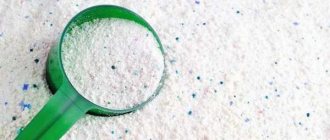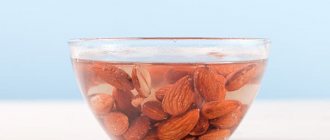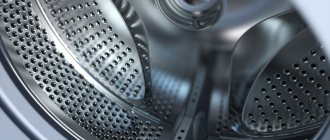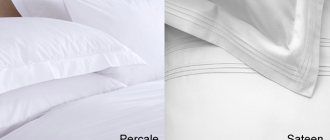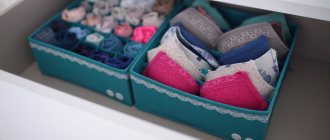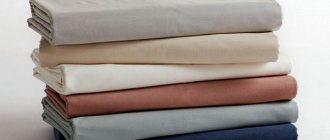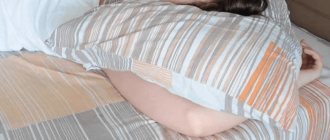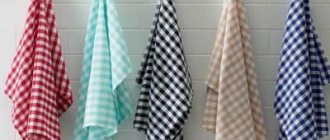Washing is a process in which every housewife can easily have her own secrets. And although the new generation of washing machines sometimes seems to perform outright cosmic functions, every second housewife does a lot of things with her own hands. For example, soaking laundry - sometimes there’s no escape from this pre-washing action.
Some people use grandma's secrets, others soak their laundry by trial and error. But how to do this correctly? This process can be described in four simple tips.
Things to consider
- Before bleaching, be sure to pay attention to the material of the product and the symbols on the label. It should indicate at what temperature the laundry can be washed. This is important because many of the methods below use boiling water. For example, synthetics cannot be cleaned in hot water, unlike linen and cotton fabrics.
- If the item is expensive and you are afraid to experiment, it is better to take it to the dry cleaner.
- If the chosen method did not help the first time, then after washing you can repeat the bleaching using the same or a different method.
Why do you need to soak clothes?
Soaking improves washing efficiency. A significant part of the stains dissolves under the action of the active components of the product used and water.
The dirt remains in the soap solution, and the laundry gets into the machine much cleaner. The washing result improves several times.
Lightly soiled clothes do not need to be soaked; the machine will deal with such a problem in one short cycle.
Stubborn stains are usually not completely removed after washing; the items have to be put back into the drum. Soaking helps avoid wasting time. After it, everything is usually washed off the first time.
How to bleach white clothes with commercial bleach
- What does it cope with? With almost everything: eliminates stains, yellowness, grayness and even helps restore color to faded items.
- What fabrics is it suitable for? Depends on the composition.
There are a large number of different bleaches, chlorine- and oxygen-containing, on store shelves.
Products with chlorine work, but can thin the fabric and ruin the color. They are used only for linen and cotton.
Therefore, it is better to give preference to oxygen bleaches. They are suitable for all fabrics, even delicate ones, and do not require high temperatures. This is important if the item cannot be washed in hot water.
How to use bleaches may vary, so follow the instructions on the package. Such products and brands as “Persol”, ACE, “BOS”, “Ushasty Nyan”, Vanish, Amway have proven themselves to be excellent.
Most often, things need to be soaked for several hours in water with bleach and washed. Or add the product directly to the washing machine along with the powder.
If the stains are strong and the fabric allows it, you can boil the laundry with bleach for at least 15 minutes and wash it in a machine.
How to soak clothes in a basin?
Fill the soak container
Use a bucket, bathtub, or basin deep enough to submerge all clothing under water. Suitable soaking areas may include a clean laundry sink, a clean bucket, or even a baby bathtub. Add enough water that you can submerge all the clothes, but not so much that adding clothes will displace the water and cause it to spill. To avoid this problem: try filling a bucket with the clothes you want to soak first, and then pouring the water onto the clothes.
- You will need to find a suitable container that you can fill with water and take the added clothing size. Remember that the weight of your clothing will increase the water level!
Add stain remover or detergent
Use the normal amount you would use to wash your clothes. Shake and stir the cleaner to ensure it dissolves in the water.
Immerse your clothes in water
Add the clothes and push them deep under the water until all the clothes are completely covered with water. Lower any pieces of fabric that float above the waterline. If you are trying to remove a small stain, consider soaking only the dyed corner of the fabric. This way you won't need as much space.
- If water spills, you have added too many clothes. Try soaking the water in stages or in several buckets at the same time.
Let your clothes get wet
The length depends on the fabric: for example, denim can be soaked for several hours, but wool or cotton should not be exposed to stain remover for more than 20-30 minutes. Do a light soak (20-30 minutes) if you're just doing a regular wash. Soak longer if you are trying to vigorously remove a tough stain.
Wash wet clothes as usual
Before washing, rinse the fabric to remove detergent. If soaking doesn't remove the stain, then you may want to consider soaking again - but be careful not to be too harsh on the fabric. More intense, localized soaking may be a way to combat tough stains.
How to bleach white clothes with a mixture of powder, bleach, oil and soda
- What does it cope with? This is a very effective way to combat yellowness and all kinds of stains. The product can remove even very old stains.
- What fabrics is it suitable for? For cotton and linen.
Pour 1 cup (250 ml volume) of laundry detergent, 4 tablespoons of good powder bleach and 1 tablespoon of baking soda into a saucepan. Pour in 4 tablespoons of sunflower oil.
Pour 10 liters of boiling water, stir and put dry things there. The quantity of necessary components can be changed, maintaining the proportions.
Place the pan on low heat for 15–20 minutes and stir the laundry occasionally. Remove from heat and let sit overnight or 6-8 hours. Then wash the items in the machine.
Selecting a remedy
Using products containing enzymes improves the soaking effect. These substances enhance the breakdown of dirt molecules and push them out of the fabric fibers. Available products also help in removing stains.
Aspirin
Acetylsalicylic acid will prevent white items from becoming yellow and gray, which appears after frequent washing. Add 4-5 crushed acetylsalicylic acid tablets to the basin where the laundry will be soaked.
Use this method for white items. T-shirts, terry towels and bed linen are soaked once a month for 20 minutes to preserve color.
Salt
Soaking laundry with salt is a universal way to remove dirt from fabric. Works well on thin synthetic materials. Veil, tulle and organza must be soaked in saline solution before washing. Using salt, remove dirt and protect the fabric from stubborn stains.
Dissolve 2 tablespoons of salt in 5 liters of warm water and place the laundry in the mixture for 15 minutes. Next, the fabric is rinsed and sent to the wash.
Soda
Helps remove yellowness and disinfects things. Suitable for natural light fabrics. May leave white streaks on black and colored materials.
Mix 6 liters of water and 0.5 cups of soda in a basin. Stir the mixture thoroughly until the powder is completely dissolved. Immerse the laundry in the basin and leave for 20-30 minutes. Then wash as usual.
Vinegar
Used to remove difficult stains from fruit and wine, prevents dyes from washing out. Items soaked in vinegar solution will retain their bright color even after many washes. Used for natural fabrics.
Add 1 glass of 9% vinegar to 10 liters of water and soak the clothes for 20 minutes. This procedure removes yellow stains from sweat and deodorant well.
Hydrogen peroxide
Removes protein-based contaminants. With its help, traces of blood, sweat and urine are removed. The stain is moistened with peroxide, left until it stops foaming and rinsed.
When bleaching, add 1 tablespoon of the product per 6 liters of water. Soaking duration is 30 minutes. Peroxide is not used on colored or black fabrics. It leaves light spots on the paint.
Mustard
An indispensable product for washing kitchen towels. Suitable for both white and colored linen. Dissolve 1 tablespoon of dry product in 5 liters of water and soak the towels for 30 minutes. The dirty water is drained and the laundry is transferred to a new solution. The procedure is repeated 2-3 times.
Potassium permangantsovka
Used to restore snow-white color, it is an optical brightener. Several crystals are thoroughly stirred in water. The solution should turn out to be a soft pink color. The laundry is soaked in the composition for 15 minutes, then wrung out and put in the washing machine.
Copper sulfate
A product that removes mold and mildew. The drug is toxic and can cause poisoning, so be sure to use gloves when working with it.
One tablespoon of powder is dissolved in 10 liters of warm water and soaked in the laundry for 10 minutes. Things are thoroughly rinsed 3-4 times and put in the washing machine.
Ammonia
It is mixed with glycerin in equal proportions to remove old stains. Apply the resulting composition to the contamination. After 15 minutes, the item treated with ammonia is soaked in a warm soapy solution.
Vegetable oil
Used to remove multiple stains of unknown origin. To do this, dissolve 0.5 cups of washing powder, 1 tbsp. in 5 liters of water. l. bleach and 3 tbsp. l. refined oil.
The resulting composition is thoroughly stirred, the laundry is immersed in it and brought to a boil and waited for 15 minutes, then the fire is turned off and left until it cools completely. Afterwards they are rinsed and put into the washing machine. Can only be used on cotton and linen.
How to bleach white things with laundry soap and soda
- What does it cope with? This method is as effective as the previous one. It helps perfectly even with old stains and yellowness.
- What fabrics is it suitable for? For cotton and linen.
Place the laundry in a container with three liters of warm water. Rub each item thoroughly with laundry soap. Add 3 tablespoons of baking soda, stir and leave for several hours.
Place the pan over low heat and simmer for about 1 hour, stirring occasionally. The liquid will become colored as it absorbs contaminants.
Rinse the laundry in warm water. Do this until it comes out clean.
We wash things as easily and quickly as possible
Many people mistakenly believe that washing by hand is a difficult task. This is wrong. You just need to prepare in advance - take a couple of basins, provide free access to water, and buy the necessary washing powder.
To the point:
- Pour warm water into the first basin and dilute the powder in it. You need to do it correctly: there should be no lumps in the liquid, otherwise things will have streaks. It is very important - the best option for hand washing is liquid laundry detergents;
- Carefully place the items in the water and wait until they are completely wet (10-15 minutes). If you start washing earlier, the fabric simply won’t wash;
- Use three hands to get the dirtiest places on the fabric, or use a not very hard brush;
- We thoroughly “mix” the products in the basin, making sure that they do not get wrapped up or entangled with each other. It is best to do this with gloves - this way the skin on your hands will not suffer;
- We take each product separately, place it in a second basin with cool water, and rinse thoroughly;
- Squeeze out the remaining moisture. If the fabric is very delicate, use a towel, not your hands!
- We send the clothes to dry. Lay out the wool and cashmere on a flat surface, placing a clean cloth underneath.
Using this technique, you can wash absolutely any fabric. An exception is socks, since they are easiest to clean under running water using laundry soap. Now let's talk about washing underwear - it also has its secrets.
How to bleach white clothes with boric acid
- What does it cope with? A solution of boric acid is not able to remove yellowness. But it will rid things of grayness and return them to their former whiteness. For example, it will refresh old washed bed linen.
- What fabrics is it suitable for? For cotton and linen, as well as for synthetics, if it is not boiled.
Dissolve 2 tablespoons of boric acid in two liters of warm water. Leave the items in the mixture for 2 hours, stirring occasionally, and wash in the machine.
If the stains are old, boiling will help. To do this, place the container with things and the prepared solution on low heat. There is no need to soak the laundry. Boil for about 1 hour and throw in the washing machine.
Tips for soaking clothes
- Read care labels before soaking This is absolutely essential. Some fabrics are ideal for soaking, but others will not withstand this procedure. In general, heavy, durable fabrics are highly absorbent, while delicate garments are better suited to short soaking. Be careful when soaking wool. It's a soft, delicate fabric, and wool clothes run the risk of drying out if you soak them for too long.
- Deal with individual stains. If the stains are particularly stubborn, it is usually worth rubbing a small amount of stain removing detergent directly into the stain. Do an internet search to determine the best practice for a specific type of stain: how to remove grass stains, food stains, urine stains, etc.
Why can’t all things be machine washed?
When it comes to a favorite item, which may have special memories associated with it, it is better to wash it by hand, controlling the process. In addition, there is a whole list of things for which it is not advisable to use a washing machine.
Below we will talk in detail about how to properly wash by hand:
- silk products;
- lace underwear;
- cashmere and wool items;
- colored fade fabrics.
Please note that there are guidelines for hand washing newborn clothing. We dare to assure you that modern washing machines cope with this task perfectly, so without a shadow of a doubt you can entrust this task to your “assistant”.
We recommend reading how to properly wash parquet boards and what products are prohibited from using.
Read: how to get rid of bedbugs in a sofa using folk remedies and special chemicals.
